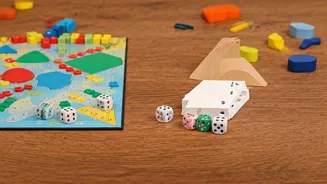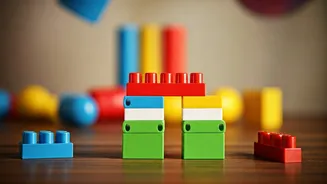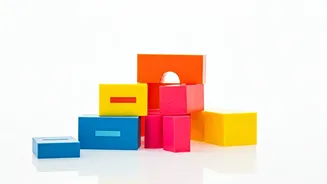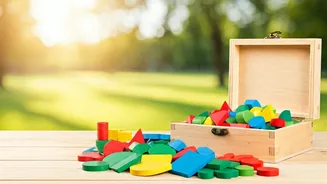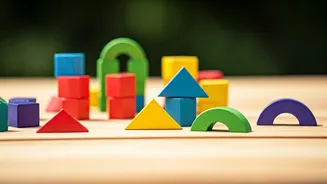Hands-On, Visual Learning
One of the most effective ways to captivate young minds in the realm of mathematics is by embracing hands-on, visual, and multi-sensory learning experiences.
This method goes beyond rote memorization and abstract concepts, allowing children to actively engage with mathematical principles through tangible activities. Consider using manipulatives like blocks, beads, or even everyday objects like fruits and vegetables to illustrate concepts. These tangible items transform abstract numbers into concrete objects, thereby improving their understanding. Visual aids such as charts, diagrams, and colorful illustrations also enhance comprehension. Furthermore, incorporate activities that stimulate multiple senses. For instance, baking a recipe together not only teaches fractions but also allows children to experience math through taste and smell. By implementing these strategies, you create a dynamic learning environment where children explore, experiment, and develop a genuine appreciation for the wonders of mathematics. This approach supports a deeper and more lasting understanding, making math less daunting and more enjoyable.
Games and Playful Fun
Transforming math lessons into a playful experience is a fantastic approach to capturing your children's interest and boosting their understanding. Instead of viewing math as a tedious task, incorporate games, puzzles, and fun activities that make learning exciting. Card games, board games, and online math games offer a delightful way to practice math skills, such as addition, subtraction, multiplication, and division, without the feeling of formal study. Puzzles like Sudoku or KenKen also sharpen problem-solving abilities and logical thinking. Embrace the opportunity to create math-related challenges. Organize a treasure hunt where clues involve solving math problems or create a math-themed scavenger hunt that incorporates measurements and calculations. The goal is to design an environment where children are so absorbed in the fun that they don't realize they're learning. By incorporating play, the subject of math becomes an adventure, boosting children's confidence and fostering a positive attitude towards numbers and mathematical principles, making them more receptive to learning.
Consistency is Key
Establishing a consistent math routine is essential for reinforcing learning and building confidence in children. Designate a specific time each day for math activities, whether it's a dedicated study session, a quick game, or an enjoyable review. This predictable schedule helps children understand that math is a fundamental part of their daily lives. By keeping the routine consistent, it becomes a habit, and children begin to anticipate and embrace their math time with greater enthusiasm. Consistency in math practice enables reinforcement and retention of concepts, which is vital for building a strong foundation. Monitor your child's progress, and adjust the pace or content as necessary to ensure they are challenged without being overwhelmed. Provide timely feedback and celebrate their achievements to boost their confidence. Also, recognize that progress isn't always linear; some days will be more challenging than others. Being consistent demonstrates commitment, nurturing a lifelong love for learning, and turning math into an enjoyable and rewarding experience. This approach helps them feel more comfortable with mathematical concepts and motivates them to continue exploring the subject.
Positive Environment
Create a positive and supportive environment to cultivate a healthy attitude towards math in your children. A child's perception of math is heavily influenced by their surroundings, and a supportive atmosphere can significantly impact their confidence and willingness to learn. Encourage them to see math as a fun activity and not a burden. Offer praise for their efforts and progress, and celebrate their accomplishments, even the smaller ones. Emphasize that mistakes are opportunities for learning and growth, rather than setbacks. By fostering a growth mindset, you teach children that their abilities can be developed through dedication and hard work. Moreover, create a space where they feel comfortable asking questions without fear of judgment. Encourage open communication, making sure they feel secure in expressing their challenges and seeking help when needed. Make math a collaborative experience by working through problems together, discussing different approaches, and celebrating the joy of discovery. This environment will not only help them build a strong foundation in math but also foster a positive attitude towards learning in general.
Real-Life Connections
Connecting math to real-life situations is an effective method to make the subject more relevant and engaging for children. When children see the practical applications of math, they realize its importance and develop a greater interest in learning. Demonstrate how math is used in everyday activities like cooking (measuring ingredients), shopping (calculating costs), or planning a trip (measuring distances). Integrate math into everyday chores, like setting the table, where they can count the number of plates and cutlery, or during playtime by building with blocks, exploring shapes, and patterns. Additionally, you can involve children in financial planning by giving them a small allowance to manage, teaching them about budgeting, saving, and spending. Explore opportunities to use math in hobbies and interests, such as sports scores, scoring in games, or even creating patterns in art. By linking math to the world around them, you demonstrate its usefulness and relevance, increasing their motivation and comprehension. This approach makes math less abstract and more practical, fostering a deeper understanding and appreciation for the subject.
Embrace Mistakes, Explore
Encouraging a growth mindset is key to helping children succeed in math. Celebrate their mistakes as learning opportunities. Mistakes shouldn't be seen as failures, but rather stepping stones toward understanding and mastery. When a child makes a mistake, guide them through the process of identifying what went wrong and how to fix it, which helps build resilience and a belief in their ability to improve. Encourage exploration by letting them try various approaches to solving a problem. This fosters creativity and deeper understanding. Show them that there isn't always only one way to solve a math problem and that experimenting with different methods is part of the learning process. Additionally, focus on building a growth mindset, which is the belief that abilities and intelligence can be improved through dedication and hard work. Congratulate their efforts and perseverance, not just their intelligence or outcomes. Cultivating a growth mindset helps children to view challenges as opportunities to learn, thus increasing their confidence and making them more willing to take risks and persevere through difficult tasks.
Digital Tools and Apps
Incorporating technology into math learning can make the subject more interactive, personalized, and enjoyable for children. Numerous educational apps and digital tools can complement traditional teaching methods. Interactive apps designed for math practice, problem-solving, and concept reinforcement can keep children engaged while providing immediate feedback. Many of these apps are designed with gamified elements, such as rewards and challenges, which can boost motivation and make learning fun. Select apps that align with their age and skill level. Digital tools, such as online calculators, can also be useful for explaining more complex problems. Use online resources and interactive websites that provide supplementary materials, videos, and tutorials. It's important to use digital resources in a balanced and wise way. Determine how much screen time is appropriate for your child. Make sure they use digital tools under supervision and guide them in their exploration to ensure they use them effectively and safely. By doing this, you can provide an enriching learning experience that boosts their understanding, and their enthusiasm for the subject.






